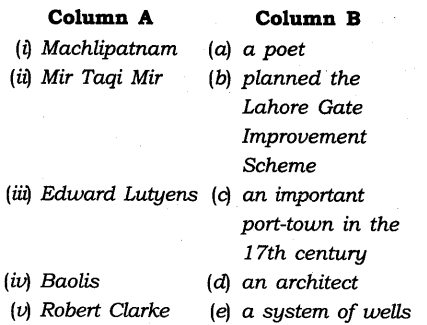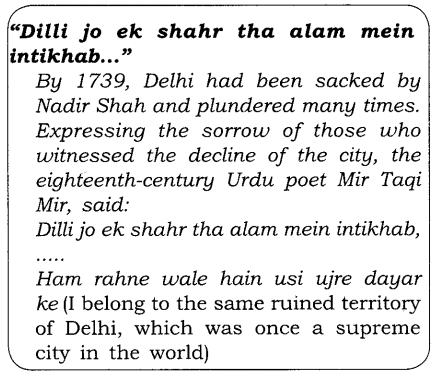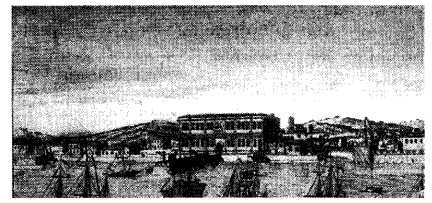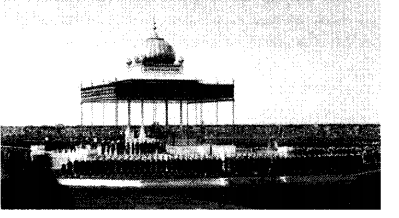NCERT Solutions for Class 8 Social Science History Chapter 6 Colonialism and the City
NCERT Solutions for Class 8 Social Science History Chapter 6 Colonialism and the City
Class 8 History Chapter 6 Colonialism and the City Ncert Textbook Questions Solved
Question 1.
State whether true of false:
- In the Western world, modem cities grew with industrialisation.
- Surat and Machlipatnam developed in the nineteenth century.
- In the twentieth century, the majority of Indians lived in cities.
- After 1857 no worship was allowed in the Jama Masjid for five years.
- More money was spent on cleaning Old Delhi than New Delhi.
Answer:
- True
- False
- False
- True
- False
Question 2.
Fill in the blanks:
- The first structure to successfully use the dome was called the …………
- The two architects who designed New Delhi and Shahjahanabad were …………… and ………..
- The British saw overcrowded spaces as …………
- In 1888 an extension scheme called the …………. was devised.
Answer:
- Central dome
- Edward Lutyens; Herber Baker
- Unhygienic
- Lahore Gate Improvement Scheme
Question 3.
Identify three differences in the city design of New Delhi and Shahjahanabad.
Answer:
Three differences were:
- Shahjahanabad was crowded with mohallas and several dozen bazaars. But New Delhi was not crowded nor were there mazes of narrow by-lanes.
- Shahjahanabad was not established in a planned manner while New Delhi was beautifully planned.
- There was chaos everywhere in Shahjahanabad. But New Delhi represented a sense of law and order. ’
Question 4.
Who lived in the ‘white’ areas in cities such as Madras?
Answer:
The British lived in the ‘white’ areas in cities such as Madras.
Question 5.
What is meant by de-urbanization?
Answer:
- De-urbanisation is a process when a large number of people from cities begin to move to other towns/villages. Lack of opportunities like trade, export from ports, and jobs related to trade and exports; was the main cause of this.
- In the 18 th century many smaller cities, many trading centres, and regional centers. If political power declined like Surat, Seringapatam, etc.
Question 6.
Why did the British choose to hold a grand Durbar in Delhi although it was not a capital?
Answer:
After the revolt of 1857, numerous events took place in Delhi.
- In 1877, Viceroy Lytton organized a Durbar to acknowledge Queen Victoria as the Empress of India.
- Calcutta was still the capital of British India, but the grand Durbar was being held in Delhi because, during the Revolt, the British realized the importance of the Mughal emperor to the people.
- It was therefore important to celebrate British power with pomp and show in Delhi.
Question 7.
How did the Old City of Delhi change under British rule?
Answer:
- The British wanted Delhi to forget its Mughal past.
-
The area around the Fort was completely cleared of gardens, pavilions, and mosques (temples were left intact) for security reasons.
- Mosques in particular were either destroyed or put to other uses.
- The Zinat-al-Masjid was converted into a bakery.
- No worship was allowed in the Jama Masjid for five years.
- One-third of the city was demolished.
- Its canals were filled up.
- In the 1870s, the western walls of Shahjahanabad were broken to establish the railways and to allow the city to expand beyond the walls.
- The Delhi College was turned into a school and shut down in 1877.
- The British now began living in the sprawling Civil Lines away from the Indians in the Walled City.
Question 8.
How did the partition affect life in Delhi?
Answer:
India got partitioned in 1947 and this led to a massive transfer of populations on both sides of the new border. As a result, the population of Delhi increased all of a sudden. The job of the people changed and the culture of the city became different. Most of these migrants were from Punjab. They stayed in camps, schools, etc. While some got the opportunity to occupy residences that had been vacated by the Muslims.
Yet others were housed in refugee colonies. New colonies like Lajpat Nagar and Tilak Nagar grew at this time. Shops and stalls were set up to cater the needs of the migrants, schools and colleges were opened. The migrants coming to Delhi were rural landlords, lawyers, teachers, traders and small shopkeepers. Partition changed their lives and occupations. They had tp take up new jobs like hawkers, vendors, carpenters, and ironsmiths.
Question 9.
Find out the history of the town you live in or of any town nearby. Check when and how it grew, and how it has changed over the years. You could look at the history of the bazaars, the buildings, cultural institutions, and settlements.
Answer:
Monu Nagar (An Imaginary Town):
- Monu Nagar was a small village along G.T. Road.
- People in the village lived a simple life, mostly of the agriculturist.
-
Slowly modern life style came.
- People started shops along the road.
- Some started repairs of vehicles, cycles, scooters and agriculture implements etc.
- Agriculture as occupation declined.
- Several schools, a college and health center developed over years.
- Some air-conditioned restaurants were opened during last five years.
- It has become a big town.
Question 10.
Make a list of at least ten occupations in the city, town, or village to which you belong, and find out how long they have existed. What does this tell you about the changes within this area?
Answer:
I live in a village, I find here the following occupations in which villagers are engaged:
- Farming
- Fishing
- Teaching
- Carpentry
- Grocery
- Vending
- Weaving
- Cattle rearing
- Blacksmith
- Barber These occupations have existed for a long time in the village.
We have seen many changes in the methods of these occupations. With the spread of education and awareness, many new technologies have been adopted. For example, in the beginning, farmers used ploughs in their fields but now they are using tractors.
Class 8 History Chapter 6 Colonialism and the City Exercise Questions
Question 1.
Choose the correct option:
(i) Which group of cities was recognized as Presidency cities?
(a) Bombay, Orissa, and Calcutta
(b) Bombay, Madras, and Vishakhapatnam
(c) Bombay, Madras, and Calcutta
(d) Madras, Rajasthan, and Calcutta
(ii) The capital of British India before Delhi was
(a) Madras
(b) Bombay
(c) Orissa
(d) Calcutta
(iii) The Delhi College was built in the year
(a) 1792
(b) 1785
(c) 1700
(d) 1695
(iv) The Viceroy’s Palace is now known as
(a) Rashtrapati Bhavan
(b) Pradhanmantri Bhavan
(c) Mantri Bhavan
(d) Raj Bhavan
(v) In 1877, Viceroy Lytton organized a grand durbar to acknowledge Queen Victoria as the Empress of India at’
(a) Calcutta
(b) Delhi
(c) Bombay
(d) Madras
Answer:
(i) (c), (ii) (d), (iii) (a), (iv) (a), (v) (b)
Question 2.
Fill in the blanks with appropriate words to complete each sentence.
- The period from ………… to …………. is referred to as a period of the Delhi renaissance.
- The western walls of Shahjahanabad were broken to establish the …………… and to allow the city to expand beyond the walls.
- New Delhi was constructed as a 10-square-mile city on …………….., south of the existing city.
- The Delhi Municipal Committee was not willing to spend money on a good …………….. system.
- Some Havelis were taken over by the upcoming …………….. class.
- The Delhi Improvement Trust was set up in ………… and it built areas like ………….. for ………… Indians.
- By the early 20th century only …………… percent of Indians were living in cities.
Answer:
- 1830; 1857
- railways
- Raisina Hill
- drainage
- mercantile
- Daiyaganj; South; wealthy
- 11
Question 3.
State whether each of the following statements is True or False.
- The central dome of the Viceroy’s Palace was copied from the Mughal architecture.
- New Delhi took at least 50 years to build.
- The population of Delhi grew all of a sudden after partition.
- The Mughal aristocracy in the 17th and 18th centuries lived in large bungalows.
- Colonies like Lajpat Nagar and Tilak Nagar grew at the time of partition.
- The cities like Machlipatnam, Surat, and Seringapatam were deurbanized.
Answer:
- False
- False
- True
- False
- True
- True
Question 4.
Match the items given in Column A correctly with those given in Column B.

Answer:
(i) (c), (ii) (a), (iii) (d), (iv) (e), (v) (b).
Class 8 History Chapter 6 Colonialism and the City Very Short Answer Type Questions
Question 1.
Name the two industrial cities in Britain.
Answer:
Leeds and Manchester.
Question 2.
Name the cities that were de-urbanized in the 19th century.
Answer:
Surat, Machlipatnam and Seringapatam.
Question 3.
Why were the main streets of Chandni Chowk and Faiz Bazar made broad?
Answer:
They were made broad for royal processions to pass.
Question 4.
Where did British live in the 1870s?
Answer:
They lived in the sprawling Civil Lines area that came up in the north.
Question 5.
Where, did the Indians live in the 1870s?
Answer:
They lived in the Walled City.
Question 6.
Why was a durbar held in Delhi in 1911?
Answer:
In 1911, when King George V was crowned in England, a durbar was held in Delhi to celebrate the occasion.
Question 7.
Who visited the durbar?
Answer:
Numerous Indian princes and British officers and soldiers visited the durbar.
Question 8.
What is Kingsway known now?
Answer:
It is now known as Rajpath.
Question 9.
Why was the Viceroy’s Palace higher than Shah Jahan’s Jama Masjid?
Answer:
The Viceroy’s Palace was higher than Shah Jahan’s Jama Masjid in order to establish British importance.
Question 10.
What jobs did the new migrants coming to Delhi take up?
Answer:
They took up jobs as hawkers, vendors, carpenters and ironsmiths.
Question 11.
What were havelis?
Answer:
Havelis were grand mansions in which the Mughal aristocracy in the 17th and 18th century lived.
Question 12.
What did the Census of 1931 reveal?
Answer:
The Census of 1931 revealed that the Walled City area was thickly populated with as many as 90 persons per acre, while New Delhi had only about 3 persons per acre.
Question 13.
Why did Machlipatnam lose its importance as a port-town by the late 18th century? [V.Imp.]
Answer:
It was because the British shifted their trade to the new ports of Bombay, Madras and Calcutta.
Class 8 History Chapter 6 Colonialism and the City Short Answer Type Questions
Question 1.
Describe the main features of Shahjahanabad, built by Shah Jahan.
Answer:
Main features are given below:
- Shahjahanabad, that was began in 1639, consisted of a fort-palace complex and the city adjoining it. Lai QUa or the Red Fort contained the palace complex.
- To its west lay the Walled City with 14 gates.
- The main streets of Chandni Chowk and Faiz Bazaar were broad enough for royal processions to pass. A canal ran down the centre of Chandni Chowk.
- The Jama Masjid was among the largest and grandest mosques in India. There was no place higher than this mosque within the city.
Question 2.
Before 1857, developments in Delhi were somewhat different from those in other colonial cities. How?
Answer:
In Presidency cities, Bombay, Madras and Calcutta, the living spaces of Indians and the British were sharply separated. Indians lived in the “black’ areas, while the British lived in well laid out “white’ areas. But in Delhi, in the first half of the 19th century, the British lived alongwith the wealthier Indians in the Walled City. The British learned to enjoy Urdu/Persian culture and poetry and took part in local festivals.
Question 3.
What happened to Delhi after 1857?
Answer:
During the Revolt of 1857, the rebels gathered in the Delhi and captured it under the leadership of the Mughal emperor Bahadur Shah Zafar. Delhi remained under the control of the rebels for four months.
When the British recaptured Delhi, they embarked on a campaign of revenge and plunder. The British forces began wrecking vengeance on the streets of Delhi, massacring the rebels. To prevent another rebellion, the British exiled Bahadur Shah to Burma, dismantled his court, razed several of the places, closed down gardens and built barracks for troops in their place.
Question 4.
How did partition change the lives and occupations of the refugees? [Imp.]
Answer:
The partition caused massive transfer of populations on both sides of the new border. Muslims left Delhi for Pakistan while their place was taken by equally large numbers of Sikh and Hindu refugees from Pakistan. Many of the Muslims who went to Pakistan were artisans, petty traders and labourers. The new migrants coming to Delhi were rural landlords, lawyers, teachers, traders and small shopkeepers. Partition changed their lives and their occupation. They had to take up new jobs as hawkers, vendors, carpenters and ironsmiths.
Question 5.
Write a short note on ‘havelis’.
Answer:
Havelis were grand mansions in which the Mughal aristocracy in the 17th and 18th centuries lived.
A haveli housed many families. On entering the haveli through a beautiful gateway, there was an open courtyard which was surrounded by public rooms. These public rooms meant for visitors and business, used exclusively by males.
The inner courtyard with its pavilions and rooms was meant for the women of the household. Rooms in the havelis had multiple uses, and very little by way of furniture. These havelis began to decline as the Mughal amirs found it difficult to maintain them under conditions of British rule.
Some havelis were subdivided and sold. Some were taken over by the upcoming mercantile class while many feel into decay.
Question 6.
Describe the main features of the colonial bungalow.
Answer:
The main features of the colonial bungalow:
- It was meant for one nuclear family.
- It was a large single-storyed structure with a pitched roof and usually set in one or two acres of open ground.
- It had separate living and dinning rooms and bedrooms and a wide verandah running in the fronts and sometimes on three sides.
- Kitchens, stables and servants’ quarters were in a separate space from the main house. The house was run by dozens of servants.
Class 8 History Chapter 6 Colonialism and the City Long Answer Type Questions
Question 1.
Discuss the construction plan of New Delhi.
Answer:
New Delhi was constructed as a 10-square-mile city on Raisina Hill, south of the existing city. Two architects namely Edward Lutyens and Herbert Baker, were called on to design New Delhi and its buildings. The government complex in New Delhi consisted of two-mile avenue, Kingsway, now known as Rajpath, led to the Viceroy’s Palace, now known as Rashtrapati Bhavan, with the Secretariat buildings on either sides of the avenue.
The features of these government buildings were borrowed from different periods of India’s imperial history, but the overall look was classical Greece of Fifth century BCE. For instance, the central dome of the Viceroy’s Palace was copied from the Buddhist stupa at Sanchi, and the red sandstone and carved screens or Jalis were borrowed from Mughal architecture.
These new buildings, had to assert British importance. Therefore, the Viceroy’s Palace was kept higher than Shah Jahan’s Jama Masjid.
Question 2.
What did the Census of 1931 reveal? What attempts were made to decongest the old city?
Answer:
The Census of 1931 revealed that the Walled City area was densely populated with as many as 90 persons per acre, while New Delhi had only about 10 persons per acre.
Several attempts were made to decongest the old city, for example, in 1888 an extension scheme called the Lahore Gate Improvement Scheme was planned by Robert Clarke for the Walled City residents. The idea was to draw residents away from the old city to a new type of market square, around which shops would be built. Streets in this redevelopment strictly followed the grid pattern and were of identical width, size and character. Land was devided into regular areas for the construction of neighbourhoods. But this development remained incomplete and did not help to decongest the old city.
In 1936, the Delhi Improvement Trust was set up. It built areas like Daiyaganj south for wealthy Indians. Houses were grouped around parks. Within the houses, space was divided according to new rules of privacy. Instead of spaces being shared by many families or groups, now different members of the same family had their own private spaces within the home.
Class 8 History Chapter 6 Colonialism and the City Source-Based Questions
Question 1.
Read the following extract (Source 1) taken from NCERT textbook (page 67) and answer the questions that follow.

Questions:
(i) What sad affair took place in Delhi 1739?
(ii) Who is Mir Taqi Mir? How does he lament over the ruins of Delhi?
Answers:
(i) In 1739, Nadir Shah sacked and plundered the city of Delhi.
(ii) Mir Taqi Mir is an eighteenth-century Urdu poet. He is one of the unfortunate persons who has witnessed the decline of the city of Delhi. He remembers those times when Delhi was a supreme city in the world. After Nadir Shah plundered this city, it became a deserted place.
Class 8 History Chapter 6 Colonialism and the City Picture-Based Questions
Observe the pictures taken from the NCERT textbook subsequently and answer the questions that follow:
Question 1.

Questions:
(i) What do you see in the above picture?
(ii) When did this city begin to grow?
Answers:
(i) The above picture is of Bombay port that existed in the 18th century.
(ii) The city of Bombay began to grow when the East India Company started using Bombay as its main port in western India.
Question 2.
The shrine of Nizamuddin Auliya in Delhi.

Questions:
(i) What does the above picture remind you?
(ii) When did this grand event take place?
(iii) What major decision was announced here?
Answers:
(i) The above picture reminds us of the Coronation Durbar of King George V.
(ii) This important event took place on 12 December 1911.
(iii) The decision to shift the capital of India from Calcutta to Delhi was announced at this Durbar.
More CBSE Class 8 Study Material
- Maths NCERT Solutions Class 8
- Science NCERT Solutions Class 8
- CBSE Class 8 Social Science Questions and Answers
- English NCERT Solutions Class 8
- NCERT Solutions for Class 8 English Honeydew
- NCERT Solutions for Class 8 English It So Happened
- Hindi NCERT Solutions Class 8
- Sanskrit Ruchira Class 8 Guide Download
- NCERT Solutions